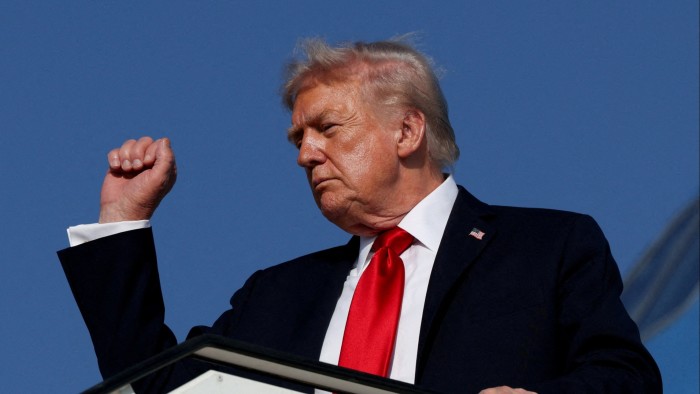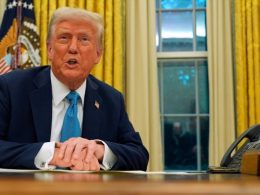Hello Sunday Free Lunchers.
With next week marking a year since the 2024 US election, I thought it would be apt to finally take on one ardent reader’s challenge to “do a counter-consensus analysis of Donald Trump’s second term”.
I took that to mean outlining a few under-reported economic upsides of the president’s policy programme — whether by design or otherwise. Coming with a trigger warning, here’s what I found.
First, Trump’s “America First” agenda has compelled leaders around the world to raise spending, enact reforms and pursue new trade deals and relations.
For example, his administration’s threat to retrench funding for Nato has raised European defence spending commitments. This has boosted regional stock markets and manufacturers this year.
The US president’s isolationism — both on trade and security — supported the case for the German parliament to loosen its constitutionally enshrined “debt brake”, enabling a major shift in the EU’s largest economy away from fiscal frugality.
Global policymakers have also set about improving competitiveness. In Canada, public support for reducing interprovincial trade barriers jumped as Trump raised tariff threats. Canadian Prime Minister Mark Carney has initiated efforts to liberalise the country’s internal market. In India, punitive duties accelerated tax reform.
As the tariff wall around the US has grown, nations and blocs have pursued trade deals with alacrity. For instance, since Trump’s re-election, the EU has struck three free trade agreements — with Mercosur, Mexico and Indonesia — and is accelerating another with India. On Tuesday, China and Asean signed an enhanced free trade pact.
“The world has been put on notice that it cannot free ride on US spending and consumers,” says Marko Papic, chief strategist at BCA Research. “Now there is a catalyst to pursue reforms and ease dependence on America, which supports long-term economic growth and stability.”
It is hard to envisage a counterfactual where policy changes would have taken place with the same speed and focus.
Another “upside” is weakness in the US dollar: “A weaker dollar tends to be good for global growth, particularly emerging markets,” says Dominic White, chief economist at Absolute Strategy Research. “It provides a boost for dollar-borrowers’ balance sheets and the terms of trade.” The administration’s measures — from protectionism and attacks on the Federal Reserve’s independence, to its weaponisation of uncertainty — have contributed to the currency’s fall.
Indeed, global economic activity, and trade in particular, has been surprisingly robust this year. Efforts to pre-empt duties have played a part, alongside policy responses to Trump and dollar depreciation. (The watering down of initial “reciprocal tariffs” has helped too.)
Second, there are some domestic “upsides” of tariffs that the White House could point to.
Analysis by the Yale Budget Lab finds industrial output in “tariff-sensitive industries has risen sharply” this year, based on data to July. (This grouping weights production by import share of output and actual effective tariff rates.)
Martha Gimbel, executive director of the YBL, cautions that this might, in part, reflect a reversion to trend, following a drop in production late last year. But she adds it may also be a response by some US manufacturers to the duties.
“All the evidence points to tariffs being a net negative for the US economy overall, but there are of course businesses that benefit from protectionism,” says Gimbel. “For those that produce simple items with relatively few outside inputs, tariffs could already be supporting production.”
Indicatively, a survey by consultancy West Monroe in June found over one-third of US companies say they are experiencing positive effects from tariffs.
Tariff revenues have also offset some of the Trump administration’s fiscal loosening.
In the 2025 fiscal year, the US budget deficit declined slightly as customs revenue hit a record high. Over the next decade the Tax Foundation expects tariffs to raise $2.3tn, after accounting for their negative economic effects. In August, S&P Global held its credit rating on US government debt citing “robust tariff income”, even as the country’s long-term debt trajectory remains a concern.
Notably, the forthcoming US Supreme Court review on the legality of Trump’s tariffs could put these revenues at risk.
Third, some White House measures are contributing to near-term resilience in the US economy, which was straining before Trump entered office.
“While the One Big Beautiful Bill Act has its ugly parts, the full, immediate and permanent expensing provisions for shortlived investment and R&D are the best legislation for businesses’ cost recovery ever signed into law,” says Erica York, vice-president of federal tax policy at the Tax Foundation.
“By lowering the cost of capital for new investment, they will support onshoring efforts and AI-related investments moving forward,” adds York.
Goldman Sachs reckons various investment incentives in the OBBBA could raise S&P 500 companies’ cash flow by about 5 per cent in 2026, and encourage incremental expenditure on capital and innovation.
The Tax Foundation forecasts the legislation’s permanent investment inducements for equipment and machinery to raise long-run US GDP by 0.6 per cent. The broader package is expected to temporarily give the US the third-best capital cost recovery tax system in the OECD, up from 21st, according to the think-tank.
Trump’s tariff threats and global dealmaking has also underpinned a surge in foreign direct investment commitments, particularly in semiconductors. The June 8 edition of this newsletter outlined why we ought to be sceptical about investment pledges. Still, actualised real FDI in the second quarter jumped to the highest level since 2022.
The administration’s lighter regulatory touch on artificial intelligence, cryptocurrency and the financial sector, despite the risks to stability, has kept markets and pockets of the private sector ticking.
“Vibes matter for investors,” adds YBL’s Gimbel. “Signals on deregulation, particularly on technology, will have contributed to exuberance.”
Indeed, recent analysis by the Bank for International Settlements highlights how “other factors” have more than offset the negative effects of tariffs on the S&P 500, and underpinned its rally since the president’s April 2 “liberation day” announcement.
The US stock market surge has, in turn, supported spending among richer cohorts, while the less well-off face growing strains.
In sum, several White House measures have propped up economic activity — particularly by egging on the tech boom — even if its broader policies undermine it.
Relatedly, it is worth acknowledging the US’s productivity spurt this year. In the first half of 2025, output per hour of labour in the durable goods sector grew by 4.9 per cent on an annualised basis, according to Juan Manuel Correa at BCA Research. That’s the fastest in close to two decades, excluding post-recession recoveries.
This looks set to continue. The Atlanta Fed’s estimate for annual third-quarter real GDP growth is just shy of 4 per cent, and the labour market is cooling.
An analysis by Correa of US industrial production per hours worked shows that productivity gains are concentrated in high-tech hardware sectors, including computers, electrical equipment and aerospace. “These are part of the broader push to produce compute power, semiconductors and data centres, and aren’t particularly labour intensive,” he says.
The administration contributes to these high-end tech gains through investment incentives, deregulation and tariff carve-outs, adds Correa. (A broader clampdown on illegal and legal immigration also encourages a shift towards more machine-driven and less labour-intensive production.)
So there is a narrow US industrial boom that is likely raising productivity, even if it is not the jobs-rich manufacturing revival Trump pledged.
Between staunch Maga supporters and those unable (or indeed unwilling) to attribute anything positive (however defined) to Trump, this was not an easy exercise.
Are there any upsides I’ve missed? Send yours to freelunch@ft.com or on X @tejparikh90.
To be clear, my views on the net and long-term economic effects of the Trump administration’s policies remain broadly negative, as I’ve outlined in depth in previous editions.
It is also true that some positives may have happened in Trump’s absence, and that he has had a degree of luck — for example, with secular trends in technology and falling interest rates. Some benefits are unintended, while others merely offset the impact of negative measures, which may soon dominate.
Still, this was a worthwhile task. Actively seeking out datapoints that run counter to our priors guards against bias and gives a more complete economic picture.
I look forward to more of your challenges.
Food for thought
Do companies deliberately use complexity as a business strategy? This blog explains the “confusopoly”.
Free Lunch on Sunday is edited by Harvey Nriapia
Source link














